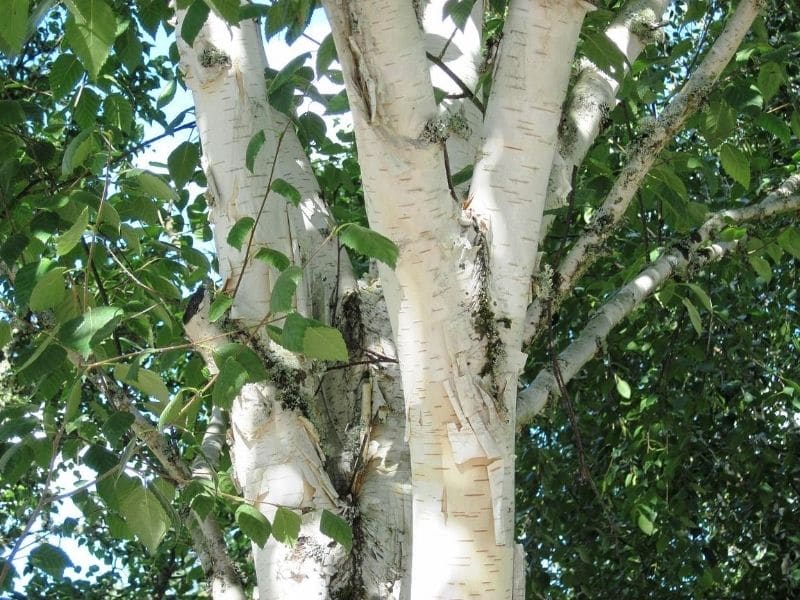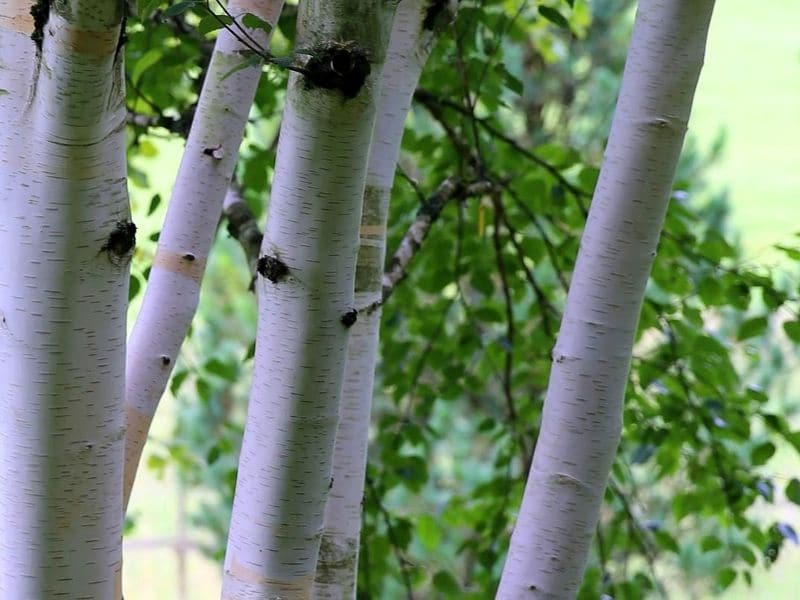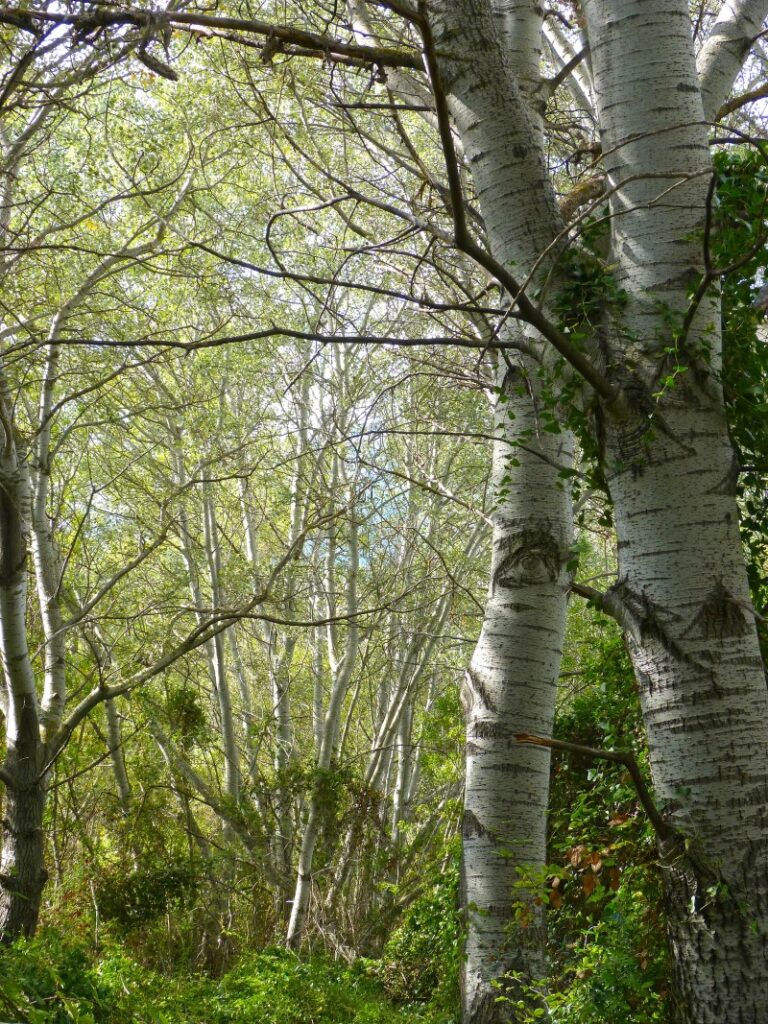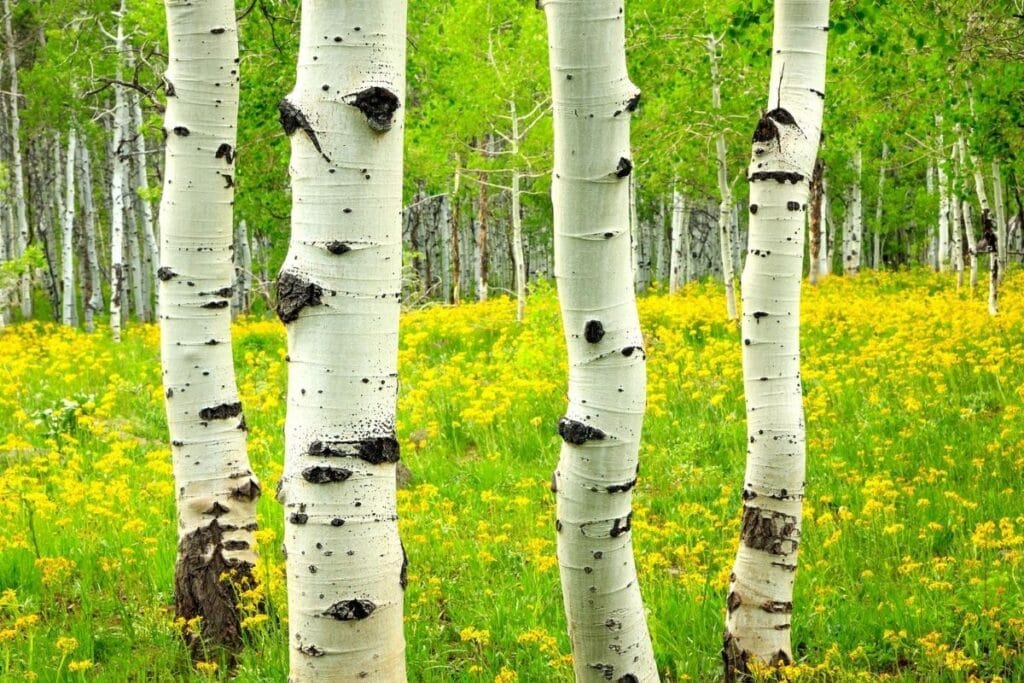Landscaping can be tough work especially if you already have a lot of features to work around. Finding trees, flowers, and shrubs that work well with those existing features is not easy, but you can make quicker work of it if you use white trees.
- #1. Paper Birch
- #2. American Sycamore (Platanus occidentalis)
- #3. Himalayan Birch Trees (Betula utilis jacquemontii)
- #4. Silver Birch
- #5. White Poplar
- #6. Erman’s Birch
- #7. Plane Tree
- #8. Quaking Aspen (Populus tremuloides)
- #9. Bald Cypress
- #10. Whitebark Pine
- #11. Spinning Gum
- #12. Betula ‘Fascination’ Birch
- #13. Brittle Gum
- #14. White Satin Birch
- #15. European Poplar
- #16. Ghost Gum
- Why Should You Grow Trees With White Bark?
From the flowers to the roots, there are all kinds of trees that produce white growth. Some of the most stunning are those trees with white bark.
Here are some of the most popular white bark trees you can choose from, they’re sure to add style and sophistication to your lawn.
#1. Paper Birch

Also referred to as the white birch, this tree is native to North America and is sometimes referred to as the canoe birch, too.
Why?
In the past, Native Americans used the bark to make canoes. These white trees not only add visual interest, but their peeling bark is great for real life applications, as you can see!
#2. American Sycamore (Platanus occidentalis)

The sycamore tree has dense white bark that will peel off the tree in patches. It has a trunk that can be split into three or so large branches, with foliage that spreads up to 70 feet wide.
The tree flourishes in most conditions, as long as it has open access to sunlight.
It can even tolerate periods of flooding. As you might expect, this tree prefers cooler climates and wet soils.
#3. Himalayan Birch Trees (Betula utilis jacquemontii)

Some types of birch trees produce brown or beige-colored bark or dark bark in general, but there are a few with white parts and trunks.
This birch tree, native to the Himalayan region as you might expect, grows well in partial to full sunlight and well-draining soil.
It grows best in zones 1 through 8—areas that have too-hot summer weather are not conducive to this tree’s health.
#4. Silver Birch

The silver birch, or European birch, native to northern Europe, is grown in many parts of the United States for its ornamental value.
As the tree develops, it produces shiny, white bark.
It’s the right tree for just about any setting, but especially those in cooler climates with somewhat wet soils.
#5. White Poplar

The white poplar grows quickly, reaching heights of 60 to 100 feet in no time.
The bark of these white trees is smooth and lightly colored, with a white hue that slowly darkens over time.
White poplars grow in a single, upright form, producing multiple small branches with a similar upright form. It has dark green leaves that turn colorful in the fall to prepare for the winter months ahead.
These trees grow best when given access to full sunlight and dry conditions.
If you want to add visual interest to your front yard, you can’t beat this deciduous tree!
#6. Erman’s Birch
Native to parts of Asia like China, Japan, Korea, and Siberia, this tree produces cream-colored bark that is perfect for developing gardens.
There are several cultivars you can choose from, including Grayswood Hill and Polar Bear.
#7. Plane Tree

Common in London, this large tree is a popular shade and ornamental tree that’s found in parks and streets all over the country.
It’s particularly admired for its bark and for its resilience to urban conditions and its gorgeous fall color.
#8. Quaking Aspen (Populus tremuloides)

A medium-sized tree, the aspen, also known as the American Aspen, only grows to about 50 feet tall, making it a good landscaping tree.
As the American Aspen tree ages, its white bark darkens and develops thick ridges.
The tree grows best in full sunlight but can also handle partial shade.
A popular feature, tree, it can tolerate occasional flooding. The American Aspen has a large range and is hardy from zones 1 to 10.
#9. Bald Cypress
The bald cypress is not entirely white, but its bark is white enough to make this list for sure! It’s found predominantly in the Florida Everglades and the bayous of Louisiana.
These trees can be incredibly old, with thousand-year-old trunks that spread out at the roots.
See more: Bald Cypress bonsai tree
#10. Whitebark Pine
Found in the western United States and Canada, this tree performs well in high altitudes, such as those found in the Rocky Mountains.
It is often grown right at the alpine tree line of mountains, making it great for alpine growing zones, and has a somewhat dwarfed, bedraggled appearance.
#11. Spinning Gum
This tree is often used in landscaping and is native to Victoria, New South Wales, Tasmania, and the Australian Capital Territory.
It does well in areas where it snows for several months out of the year, typically the lower hardiness zones.
The spinning gum adds instant curb appeal with its beautiful horizontal branches and snowy white bark, so you may want to consider growing it as a specimen tree.
#12. Betula ‘Fascination’ Birch
A very specific cultivar of birch, this tree, also known as Betula papyrifera, produces bark that can vary from orange-copper to fully white when peeled back.
In fact, it provides major visual interset with its bark – it’s some of the whitest bark you’ll find.
The tree matures quickly, pushing out rapid growth and a gorgeous canopy.
It offers year-round interest to a lawn or garden, making it a good choice for a winter garden.
This tree with white bark prefers full sun and well drained soil.
#13. Brittle Gum
Another gumtree to consider is brittle gum. It’s a eucalyptus species with white/grey bark.
#14. White Satin Birch
Another type of birch tree with white bark is the White Satin Birch. This tree also grows quickly, producing a dense, deciduous habit.
It has leathery bright green leaves that become darker as the season progresses and you experience high temperatures.
After the summer temperatures drop back down, the leaves eventually turn a deep golden yellow in the fall.
This is a unique tree that is wonderful for people living in temperate areas!
#15. European Poplar
Frequently referred to as the Eurasian Poplar, this tree is grown throughout parts of northern Europe and Iceland.
It looks a lot like other types of Aspen (like the American Aspen) but has bark that’s a bit more gray than just pure white.
Be careful growing it if you live in the United States, as it has an invasive nature. It’s not ideal for small gardens.
Nevertheless, it remains a popular choice for many people.
#16. Ghost Gum
Native to Australia, these trees with white bark offer a stark contrast to your landscape.
The ghost gum forms a single main trunk that eventually splits itself into multiple small branches. The tree has long leaves with a feathery appearance. It prefers well drained soil and full sun.
The tree is only hardy in zones 9 to 11 but can otherwise tolerate most growing conditions.
Why Should You Grow Trees With White Bark?
Trees with white bark can add a touch of class to any landscape.
Although you won’t be able to grow a gum tree if you live in the American Midwest, you will likely be able to grow a large number of the other tree species on this list.
And believe it or not, there are plenty of other trees with white bark out there that might be well suited to your environment.
Some other common choices include the river birch, silver poplar, the trembling aspen, the snow gum, and much more.
Choose the trees with white bark that mesh best with your growing zone, and remember, it doesn’t matter which type of tree you choose.
From birch trees to the ghost gum, the American sycamore to the Japanese white birch, your options are endless.
At the end of the day, you can’t go wrong when you decide to grow trees with white bark!
Photo by JohnnyAdolphsonPhotography/depositphotos







